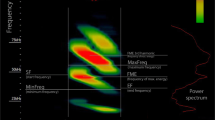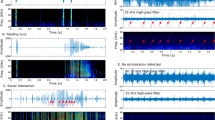Summary
Saccopteryx bilineata, Cormura brevirostris and two other species tentatively identified as emballonurid bats, were recorded in the field in Panama. The search and approach phase calls of all the species began with a rise in frequency followed by a constant frequency (CF) portion and a terminal drop in frequency.S. bilineata and one of the unknown species produced pairs of calls, the first 2–3 kHz lower in CF frequency than the second. This has been suggested as associated with Doppler shifts of echoes caused by the bats' flight and bats' beaming calls towards different targets. However, a second unidentified species produced call triplets with the total difference in CF frequencies too great to be explained by this hypothesis. Increased bandwidth and integration of echo information, or social communication may be alternative functions. Terminal phase calls of three of the species were typical frequency modulated signals.C. brevirostris terminal calls, however, were CF in nature, a form not believed to be suitable for tasks requiring high resolution such as prey pursuit. The characteristics of these bats' signals are more complex than previously suggested and bring into question their supposed ‘primitive’ nature.
Similar content being viewed by others
References
Ahlen I (1981) Identification of Scandinavian bats by their sounds. Swed Univ Agr Sci, Dept Wildlife Ecol Rep 6, Uppsala, Sweden
Barclay RMR (1982) Interindividual use of echolocation calls: Eavesdropping by bats. Behav Ecol Sociobiol 10:271–275
Bonnacorso FJ (1979) Foraging and reproductive ecology in a Panamanian bat community. Bull Fla State Mus Biol Ser 24:359–408
Bradbury JW, Vehrencamp SL (1976) Social organization and foraging in emballonurid bats. 1. Field studies. Behav Ecol Socibiol 1:337–381
Fenton MB, Bell GP (1979) Echolocation and feeding behaviour of four species of Myotis (Chiroptera). Can J Zool 57:1271–1277
Fenton MB, Bell GP (1981) Recognition of species of insectivorous bats by their echolocation calls. J Mammal 62:233–243
Fenton MB, Fullard JH (1979) The influence of moth hearing on bat echolocation strategies. J Comp Physiol 132:77–86
Fenton MB, Bell GP, Thomas DW (1980) Echolocation and feeding behaviour ofTaphozous mauritianus (Chiroptera: Emballonuridae). Can J Zool 58:1774–1777
Griffin DR (1971) The importance of atmospheric attenuation for the echolocation of bats (Chiroptera). Anim Behav 19:55–61
Griffin DR, Webster FA, Michael CR (1960) The echolocation of flying insects by bats. Anim Behav 8:141–154
Griffin DR, Dunning DC, Cahlander DA, Webster FA (1962) Correlated orientation sounds and ear movements of horse-shoe bats. Nature 196:1185–1186
Grinnell AD (1970) Comparative auditory neurophysiology of neotropical bats employing different echolocation signals. Z Vergl Physiol 68:117–153
Habersetzer J (1981) Adaptive echolocation sounds in the batRhinopoma hardwickei: A field study. J Comp Physiol 144:559–566
Lawrence BD, Simmons JA (1982) Measurements of atmospheric attenuation at ultrasonic frequencies and the significance for echolocation by bats. J Acoust Soc Am 71:585–590
Novick A (1962) Orientation in neotropical bats. 1. Natalidae and Emballonuridae. J Mammal 43:449–455
Novick A (1977) Acoustic orientation. In: Wimsatt WA (ed) Biology of bats, vol 3. Academic Press, New York, pp 73–287
Pye JD (1973) Echolocation by constant frequency in bats. Period Biol 75:21–26
Pye JD (1978) Some preliminary observations on flexible echolocation systems. In: Olembo RJ, Castelino JB, Mutere FA (eds) Proc 4th Int Bat Res Conf, Kenya Nat Acad Arts Sci, pp 127–135
Pye JD (1980) Adaptiveness of echolocation signals in bats. Trends Neurosci 3:232–235
Simmons JA (1980) Phylogenetic adaptations and the evolution of echolocation in bats. In: Wilson DE, Gardner AL (eds) Proc 5th Int Bat Res Conf. Texas Tech Press Lubbock, Texas, pp 267–278
Simmons JA, Stein RA (1980) Acoustic imaging in bat sonar: Echolocation signals and the evolution of echolocation. J Comp Physiol 135:61–84
Simmons JA, Fenton MB, Ferguson WR, Jutting M, Palin J (1979a) Apparatus for research on animal ultrasonic signals. Life Sci Misc Publ, R Ontario Mus, Toronto, Ontario
Simmons JA, Fenton MB, O'Farrell MJ (1979b) Echolocation and the pursuit of prey by bats. Science 203:16–21
Suthers RA (1970) Vision, olfaction and taste. In: Wimsatt WA (ed) Biology of bats. Academic Press, New York, vol 2, pp 265–309
Tuttle MD (1974) An improved trap for bats. J Mammal 55:475–477
Woodsworth GC, Bell GP, Fenton MB (1981) Observations of the echolocation, feeding behaviour, and habitat use ofEuderma maculatum (Chiroptera: Vespertilionidae) in southcentral British Columbia. Can J Zool 59:1099–1102
Author information
Authors and Affiliations
Rights and permissions
About this article
Cite this article
Barclay, R.M.R. Echolocation calls of emballonurid bats from Panama. J. Comp. Physiol. 151, 515–520 (1983). https://doi.org/10.1007/BF00605468
Accepted:
Issue Date:
DOI: https://doi.org/10.1007/BF00605468




